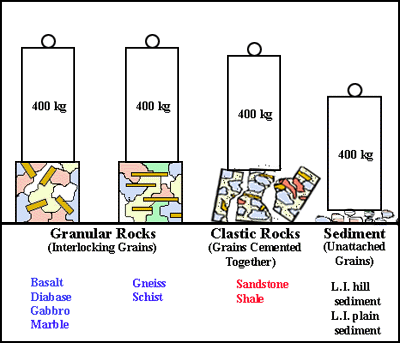CALCULATING A 'COHESION VALUE'
The cohesion of a geologic material refers to the strength with which the particles out of which it is composed are attached to each other.
- High Cohesion (H): If the particles are interlocked like the pieces of a jigsaw puzzle (granular rocks), the attachment is strong; the material resists breaking apart.
- Intermediate Cohesion (I): If the particles are cemented together (clastic rocks), their attachment depends upon the strength of the cement. For cemented materials in the NYC area, the cement is only moderately strong; the strength of the attachment is intermediate; the material has intermediate resistance to breaking apart.
- Low Cohesion (L): If the particles are not attached to each other at all (loose sediment), the material easily breaks apart.
To review the Cohesion 'rollover', click on the blue button. 
From examination of the 'rollover', the relative strengths of cohesion of granular rocks, clastic rocks, and sediment are readily apparent.
Numerical equivalents may be assigned to cohesion: - high cohesion:
(H) = 7.00 - intermediate cohesion:
(I) = 3.00 - low cohesion:
(L) = 0.00 - Note that these values are expressed to TWO decimal places.
To determine Cohesion Values for the NYC rocks and sediments, follow these steps (see example):
- Print out a copy of the 'Cohesion Value Calculation Table', (printout # Q-5).

- For each rock or sediment, indicate its particle relationship and cohesion strength by a check mark. (Obtain this information from the 'Cohesion Rollover'.)
- Enter the numerical equivalent of the cohesion strength.
- Enter the Cohesion Value (which is numerically equal to the cohesion strength).
 | |